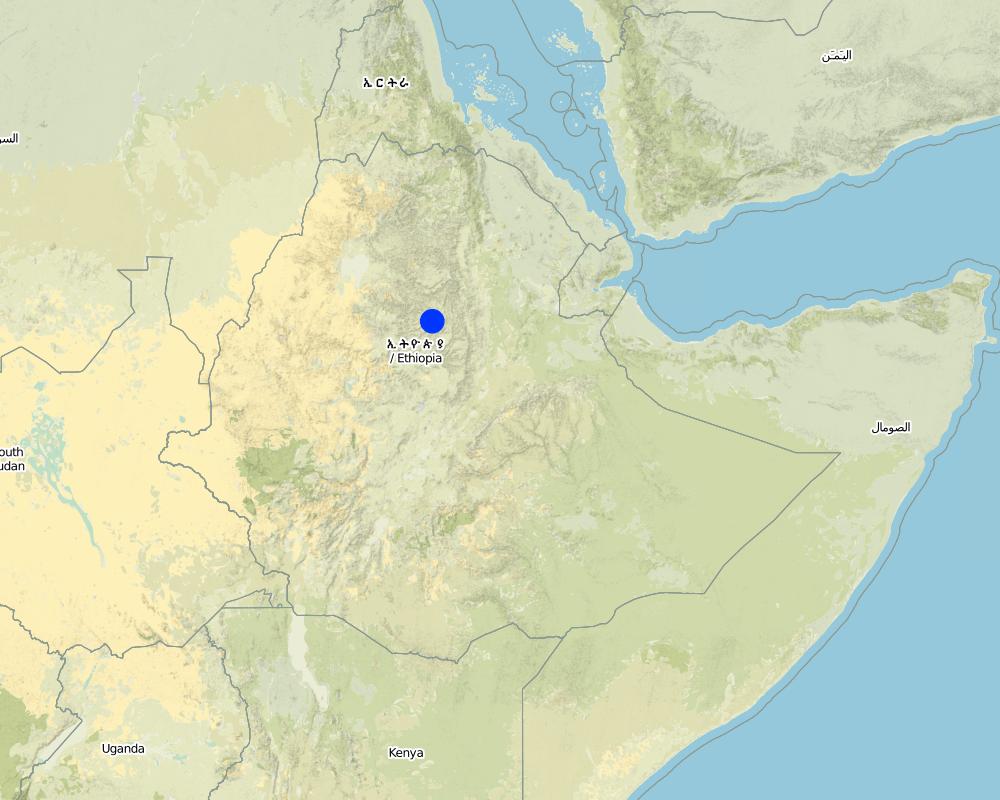Local Level Participatory Planning [埃塞俄比亚]
- 创建:
- 更新:
- 编制者: Philippe Zahner
- 编辑者: –
- 审查者: Fabian Ottiger
approaches_2385 - 埃塞俄比亚
查看章节
全部展开 全部收起1. 一般信息
1.2 参与方法评估和文件编制的资源人员和机构的联系方式
有助于对方法进行记录/评估的机构名称(如相关)
Swiss Agency for Development and Cooperation (DEZA / COSUDE / DDC / SDC) - 瑞士1.3 关于使用通过WOCAT记录的数据的条件
编制者和关键资源人员接受有关使用通过WOCAT记录数据的条件。:
是
2. SLM方法的描述
2.1 该方法的简要说明
LLPPA is community involved participatory planning for integrated and sustainable development
2.2 该方法的详细说明
该方法的详细说明:
Aims / objectives: To ogrganize the community member to contribute their free labour in SWC activities and to conserve the land.
Methods: The methods are using vernurablity rank to form groups to participate through the approach, select PDT (participatory Development Team) to under take.
Stages of implementation: Stages of implementations are introduced prepared plan with PDT to the community, site selection for each activity, design and layout, organize the community in working groups, under take the actual selected activity on the ground. Role participants are providing suggestions/ideas during the discussion, select PDTs based on vernurablity ranking and gender proportion aspect, prepare plan of action through PDTs direct involvement during implementation.
Role of stakeholders: Participants are providing suggestions/ideas during the discussion, select PDTs based on vernurablity ranking and gender proportion aspect, prepare plan of action through PDTs direct involvement during implementation.
2.5 采用该方法的国家/地区/地点
国家:
埃塞俄比亚
区域/州/省:
Soth Wollo/Amhara
Map
×2.6 该方法的开始和终止日期
注明开始年份:
2000
2.7 方法的类型
- 基于项目/方案
2.8 该方法的主要目的/目标
The Approach focused mainly on SLM with other activities (homestead vegetables plantation, income generating activities, rainwater harvesting, HIV/AIDS, gender issues)
to organize and creat awarness within the community in order to contribut their free labour for SWC and other related activities
The SLM Approach addressed the following problems: creating ownership of each activities, solve soil/lad degradation problem, through participatory undertaking on sustainable base, solve food shortage problem through availing food grain.
2.9 推动或妨碍实施本办法所适用的技术的条件
财务资源和服务的可用性/可得性
- 阻碍
shortage of input
Treatment through the SLM Approach: community awarness to participate with its available resources (labour + tools)
机构设置
- 阻碍
unsufficient staffing, lack of office equipment
Treatment through the SLM Approach:
法律框架(土地使用权、土地和水使用权)
- 启动
The existing land ownership, land use rights / water rights moderately helped the approach implementation: Planning, working together, labour saving
了解SLM,获得技术支持
- 阻碍
shortage of skilled manpower
Treatment through the SLM Approach: provision of training & support technically
3. 相关利益相关者的参与和角色
3.1 该方法涉及的利益相关者及其职责
- 当地土地使用者/当地社区
Working land users were work equally divided between men and women
Actual work. Involvment of disadvantaged groups through PDTs
- 国家政府(规划者、决策者)
Training, planning, technical support
- 国际组织
Financial and technical support
3.2 当地土地使用者/当地社区参与该方法的不同阶段
| 当地土地使用者/当地社区的参与 | 指定参与人员并描述活动 | |
|---|---|---|
| 启动/动机 | 被动 | public meetings |
| 计划 | 互动 | Mainly: PDTs; partly: interviews/questionnaires |
| 实施 | 外部支持 | responsibility for minor steps |
| 监测/评估 | 互动 | measurements/observations; |
| Research | 无 |
3.4 有关SLM技术选择的决策
具体说明谁有权决定选择要实施的技术:
- 主要是土地使用者,由SLM专家提供支持
解释:
Decisions on the method of implementing the SLM Technology were made by mainly by SLM specialists with consultation of land users. LLPPA is appropraite
4. 技术支持、能力建设和知识管理
4.1 能力建设/培训
是否为土地使用者/其他利益相关者提供培训?:
是
明确受训人员:
- 土地使用者
- SWC specialists, extensionists/trainers (2), politicians/decision makers (3)
培训形式:
- 在职
- 农民对农民
- 示范区域
涵盖的主题:
SWC and LLPPA and others
4.2 咨询服务
土地使用者有权使用咨询服务吗?:
是
指明是否提供了咨询服务:
- 在土地使用者的土地上
说明/注释:
1) Advisory service was carried out through: government's existing extension system; Extension staff: mainly government employees 2) Target groups for extension: land users; Activities: SWC and other activities
Advisory service is quite adequate to ensure the continuation of land conservation activities; The community is interested to protected degradation and gain benefits
4.3 机构强化(组织发展)
是否通过这种方法建立或加强了机构?:
- 是,非常
具体说明机构的强化或建立程度:
- 本地
具体说明支持类型:
- 能力建设/培训
- 设备
4.4 监测和评估
监测和评估是该方法的一部分吗?:
是
注释:
bio-physical aspects were regular monitored through observations
technical aspects were regular monitored through observations
socio-cultural aspects were ad hoc monitored through observations
economic / production aspects were ad hoc monitored through observations
area treated aspects were regular monitored through observations
no. of land users involved aspects were regular monitored through observations
management of Approach aspects were regular monitored through observations
5. 融资和外部物质支持
5.2 为土地使用者提供财政/物质支援
土地使用者是否获得实施该技术的财政/物质支持?:
是
5.3 对特定投入的补贴(包括劳动力)
- 设备
| 具体说明哪些投入得到了补贴 | 程度如何 | 对补贴做出具体说明 |
|---|---|---|
| 工具 | 部分融资 | Hand tools |
- 农业
| 具体说明哪些投入得到了补贴 | 程度如何 | 对补贴做出具体说明 |
|---|---|---|
| 种子 | 充分融资 | |
| Seedlings | 充分融资 | |
- 基建
| 具体说明哪些投入得到了补贴 | 程度如何 | 对补贴做出具体说明 |
|---|---|---|
| Community infrastructure | 部分融资 | |
如果土地使用者的劳动力是一项重要的投入,那么是不是:
- 以粮换工
注释:
the approach is based on food for work
6. 影响分析和结论性陈述
6.1 方法的影响
该方法是否帮助土地使用者实施和维护SLM技术?:
- 否
- 是,很少
- 是,中等
- 是,支持力度很大
Planning, working together, labour saving
Did other land users / projects adopt the Approach?
- 否
- 是,很少
- 是,中等
- 是,支持力度很大
6.3 方法活动的可持续性
土地使用者能否维持通过该方法实施的措施(无外部支持的情况下)?:
- 是
6.4 该方法的长处/优点
| 编制者或其他关键资源人员认为的长处/优势/机会 |
|---|
| creat awarness (How to sustain/ enhance this strength: training, workshop) |
| large area can be conserved (How to sustain/ enhance this strength: provision of hand tools) |
7. 参考和链接
7.1 方法/信息来源
- 实地考察、实地调查
- 与土地使用者的访谈
链接和模块
全部展开 全部收起链接
无链接
模块
无模块


